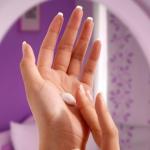To the barrier: what are ceramides and why are they needed. Ceramides: what is it, why are they needed in cosmetics and how do they affect youthful skin? Ceramides in cosmetics
Just as fat improves the taste of food, ceramides (or ceramides) improve the quality of our skin, keeping it hydrated and fresh. The main function of ceramides in the skin is construction; they fill the space between cells. If we draw an analogy, cells are bricks, and ceramides are the cement mortar that holds these bricks together. So if there are not enough ceramides or they are of poor quality, then the integrity of the skin suffers. She becomes dehydrated, becomes dry, irritated, and inflammation appears.
What are ceramides?
Must Know
Ceramides (ceramides) - from lat. cerebrum “brain” - are a type of lipids (fats). They are located in the hydrolipid layer of the skin and are needed to protect against aggressive factors, as well as to prevent moisture loss.
Additionally, ceramides—even more than retinol, niacinamide, and peptides—are one of the anti-aging powerhouses responsible for maintaining the dynamic nature of the skin. Two ceramide precursors—phytosphingosine and sphingolipids—actually help the skin produce more ceramides.
As you already understand, there may be a lack of ceramides. This is affected by age, skin damage from the sun and other negative environmental factors. By age 30, we lose about 40% of ceramides, and by age 40, about 60%. And this is where skin care knowledge comes into play - because you can actually restore what has been lost.
Will cosmetics with ceramides help me?
It will help if they are properly formulated and packaged formulas. A Japanese study showed an increase in skin moisture by more than 100% when using cosmetics with ceramides. What does "packed" mean? The fact is that most anti-aging ingredients that are most beneficial for the skin are not stable. Simply put, they lose their effectiveness when exposed to light and air - which is what happens every time you open a jar of cream. Look for products in tubes or opaque bottles with pumps or airtight dispensers to keep your anti-aging products the way they should be.
Cosmetologists say that ceramides can be included in care, regardless of what it includes. Apply the product in the morning or evening - it doesn't matter. Ceramides will work well on the face, body and hair as part of creams, serums and essences. But ceramides in cleansers have no value - you just wash them off.

For what skin type are cosmetics with ceramides suitable?
Ceramides fall under the category of “skin repairing” ingredients. Since ceramides are a natural part of the body, they are ideal for all skin types, even the most sensitive. They are also safe to use around the eyes as long as the product is free of fragrances and irritants.
Why do we need ceramides for hair?
Ceramides play the same role in hair as they do in skin. Accordingly, they are responsible for hair strength, shine, smoothness and weather resistance. Coloring, blow-drying, and styling deplete the amount of ceramides in your hair. Using products with them will help restore the correct balance in your hair and minimize damage.
Ceramides are most beneficial for hair that has been chemically treated. Natural hair also benefits from products containing ceramides; Simply, as with any conditioning, nourishing or restructuring ingredients, the more damaged the hair is, the better it works. Luckily, ceramides are readily available in tons of products—both natural and synthetic. Both are valuable for hair, but synthetic ceramides more closely mimic those found inside the hair cuticle than plant-based ones. Pay attention to the following ingredients in hair masks: 2-oleamido, 1-3 octadecanedio, wheat germ oil, safflower oil, grape seed oil, sunflower oil, hemp seed oil.
Is it possible to nourish the skin from the inside?
Good sources of ceramides include beans, eggs, dairy products, wheat germ and brown rice. There are also many dietary supplements with ceramides, but doctors are not clear on their effectiveness. Since these are lipids, you need to be quite careful - they can potentially aggravate heart disease.

How do you know if cosmetics contain ceramides?
Typically, you'll see the word "ceramide" followed by the prefix AP, EOP, NG, NP, or NS on the ingredient label. But not always. For example, phytosphingosine and sphingosine are ingredients known as ceramide precursors, meaning they can trigger the skin to produce ceramides. However, given that ceramides are highly promoted as anti-aging ingredients, most brands use this fact in their marketing campaign.
When you read the label, pay attention to the entire composition. Ceramides are most effective in combination with other skin-restoring ingredients - fatty acids, glycerin, cholesterol. Such lipid mixtures are ideal for improving skin tone, texture and relieving signs of sensitivity. But since no single ingredient can do everything to combat visible signs of aging, make sure your ceramide-enriched product contains antioxidants and what are called "skin-repairing" ingredients; for example, retinol, niacinamide, linoleic acid and peptides.
When it comes to choosing beauty products to keep your skin looking youthful and healthy, it's easy to get fooled and spend money on a cream that isn't worth it. The information space is teeming with information about anti-aging ingredients, but these substances do not always act as we would like.
In this article we will talk about a component that is really necessary when caring for aging skin. We'll talk about ceramides.
What it is
Ceramides are the largest group of unique waxy lipids found in the stratum corneum of the skin. The stratum corneum is the outermost layer of "dead" fibrous protein cells tightly sealed in a lipid matrix. In turn, the matrix is an alternation of lipid layers, between which there is an aqueous layer (bilayers). This arrangement of the upper layer of skin is the main obstacle to the penetration of external substances.
Skin cells, whose life path is known to move from the basement membrane to the stratum corneum, contain special organelles for the production of lipids, as well as enzymes that are capable of modifying these lipids. At the end of the life cycle, the cell is “flattened” and the lipid component, together with enzymes, is poured into the intercellular space. During their interaction, ceramides, fatty acids and cholesterol are formed, which are necessary for the construction of bilayers.
All this can be compared to a tiny ecosystem, the balance of which is easily upset. For example, “wash out” cholesterol and fatty acids with aggressive cleansers, or damage the stratum corneum with the aesthetic procedure of chemical peels, or even shift the pH of the skin to alkaline, and then skin lipids, in particular ceramides, will not be able to form correctly and the skin will become less protected. But even with the best care, the production of ceramides decreases with age, which ultimately leads to dermatoses, dryness and accelerated aging.
How it works
There are at least 9 different types of ceramides in our skin, and each of them has a different role. In general, “short” ceramides provide “stiffness” to the skin, while “long” ceramides provide its elasticity. The right balance gives us the perfect facial contour. But ceramides are not only the main structuring element, they are also regulators of cellular processes, for example, they can accelerate the reproduction and development of new cells, the death of “defective” cells, and even influence the synthesis of new collagen.
Ceramides penetrate easily because they are skin-identical molecules. It has been proven that ceramides applied to the surface of the skin can move in the upper layers of the epidermis. There is a huge research base proving that ceramides are really effective in maintaining skin health, Japanese scientists have especially tried, proving that ceramides not only restore the damaged barrier, but also protect the stratum corneum from potential attacks by surfactants.
At the same time, other studies emerged that suddenly showed that ceramides were no better at protecting the skin than petroleum jelly. In particular, a mixture “mimicking” the barrier and consisting of ceramide-3, palmitic and oleic acid and cholesterol was tested on volunteers. When compared with regular occlusive petroleum jelly cream, the results were almost identical.
After these conflicting results, scientists redoubled their efforts and eventually discovered that it was the ratio of the ingredients that mattered. A “formula for success” was developed. It turned out that for cosmetics the best ratio of ceramides, cholesterol and free fatty acids is 1:1:1 or 3:1:1. When we talk about creams “with ceramides,” it usually means a mixture with fatty acids and cholesterol/lecithin in the “correct” ratio.

Creams use only a few types of ceramides, and not all 9, mainly ceramides 1 and 3 (retain moisture inside the skin and reduce irritation), less often you can find additional ceramides 4, 5 and 6 (mainly in specialized products for the treatment of psoriasis or eczema).
Today on labels you can see not only ceramides (Ceramide 3, Ceramide 1), but also phytoceramides (Phytoceramide), pseudoceramides (Cetyl-PG Hydroxyethyl Palmitamide), etc. This creates some confusion, but in reality everything is not so complicated.
- Phytoceramides are obtained from yeast and completely replicate the structure of the “native” human ceramide.
- Pseudoceramides - have properties similar to ceramide, but a different structure. These are patented substances from the brand’s laboratories; they are similar in characteristics and are an almost ideal replacement for natural ceramides.
- Synthetic ceramides are a completely lab-synthesized version of natural ceramide.
By the way, almost all ceramides used in cosmetics are synthetic. Natural ceramides in plants are present in very low concentrations, so such raw materials are too expensive. And since our body does not see the difference (if ceramide has the correct structure), then there is no point in overpaying.
So if you want to add ceramide products to your routine, start with cheap products that may contain only one ceramide, and if you like the effect, move on to more expensive ones and continue the process until you find what suits you.
Tatiana Morrison
Photo istockphoto.com
Liposomes are actively used in cosmetics. They often contain ceramides. What kind of connections are these?
Our skin consists of several layers. The top one - epidermis thickness 75 -150 microns. Its main function is protection from mechanical damage, from the penetration of foreign substances, viruses, bacteria. In addition, it limits the evaporation of water from the surface of the skin. The epidermis is also multilayered. The cells of the lower layer divide, and their descendants, who do not have enough space there, are squeezed up and gradually move towards the surface.
The function of these cells is to protect the delicate inner contents of a person with their dead bodies. Moving into the upper layers of the skin, they degrade: they lose water, their DNA disintegrates. The top layer of the epidermis, called the stratum corneum, is made up of layers of dead, dehydrated cells. It is constantly exfoliated; its renewal period for normal skin is 20-90 days. So, before dying, the cells of the stratum corneum synthesize special lipids, which then cement their corpses into a kind of brickwork. Like other membrane lipids, they have hydrophobic “legs,” which in Russian have been called ceramides for several decades. These are the ones "ceramides", which are constantly repeated to us from the screen. "Hydroxyceramides", which are also mentioned in the advertisement, are, as you can now guess, the same ceramides with an extra hydroxyl group. Root "cer" comes from Latin "cerebrum"-brain, because they were first isolated from the brain. And those imposed on us "ceramides"-just an incorrect transcription of the word "ceramide".
That is Ceramides/ceramides- these are substances of natural origin, solid or waxy substances of lipid nature (sphingolipids), which together with cholesterol and fatty acids form the lipid barrier layer of the skin. When the surface layer of the skin is damaged, ceramides fill the gaps formed as a result of leaching, reduce skin permeability, reduce water loss and improve the elasticity of the epidermis.
Ceramides
belong to the class of sphingolipids. These are complex lipids consisting of several blocks - the fatty alcohol sphingosine or phytosphingosine (forms a hydrophilic “head”) and one fatty acid (lipophilic “tail”).
Among ceramides
Long-chain ceramides of type 1, which include linoleic acid, are particularly prominent. These ceramides stitch adjacent lipid layers and bind them into a single structure. With a lack of linolenic acid, synthesis suffers ceramides
1, accordingly, the lipid layer of the stratum corneum loses its integrity and disintegrates. The consequence of this is dry skin and other associated symptoms (flaking, increased sensitivity, irritation, etc.).
Restoration of epidermal lipids. These components ensure the connection of epidermal cells with each other. If we compare the skin to a brick wall, then the epidermal cells will act as bricks, and epidermal lipids will act as the matrix, cement. In reality, epidermal lipids (primarily ceramides, or ceramides) are very fragile substances, but they perform important functions: they ensure the resistance of the epidermis to the penetration of foreign microorganisms, and also participate in the effective hydration of the skin. To support the functions of epidermal lipids, their analogues (for example, rice ceramides) are introduced into cosmetics.
The use of ceramides for acne
To treat and eliminate signs of acne, a fairly wide range of drugs is used; modern developments have made it possible to obtain highly effective components of acne treatment products - ceramides. Treatment of acne with ceramides eliminates the pathological process in the skin by restoring the structure of the epidermal barrier and normalizing the chemical composition of epidermal lipids.
With insufficient synthesis of ceramides in the stratum corneum, areas completely devoid of the lipid matrix appear, the stratum corneum thickens and its permeability increases, resulting in dry skin, peeling, and itching. Violation of the skin barrier leads to a significant deterioration in the condition and appearance of the skin. Microorganisms and substances that previously did not penetrate the skin (for example, some chemical ingredients of cosmetics) can penetrate through a broken barrier. This can cause infectious skin diseases and allergic reactions, which aggravate the course of acne. In addition, damage to the lipid barrier causes skin dehydration, which causes the skin to lose its elasticity and wrinkles to appear.
Plant ceramides
Vegetable ceramides- are completely natural and of plant origin, extracted from rice. Ceramides characterized by the ability to fill the physiological gaps between epidermal cells, i.e. improving the quality of the stratum corneum of the skin. Complex structure ceramides in its origin, it has a lipid-structural characteristic that allows the scaly layers to “cement” intercellularly. Complex rice ceramides
is a mixture of sphingolipids (ceramides) and phospholipids. Ceramides play an important role in the structure and functioning of the stratum corneum of the skin. They are characterized by the ability to fill the physiological gaps between epidermal cells, thus improving the quality of the stratum corneum of the skin.
Method of preparation: extracted with ethanol from rice bran and rice germ of Oryza sativa Linne (Gramineae). Contains at least 3.0% glycosphingolipids.
Cosmetic use
tion
:
The barrier function is very important: it allows you to combat the daily aggressive influence of the environment, temperature differences, pollution, solar radiation and physical and chemical influences. Quickly absorbed ceramides dissolve in the stratum corneum and fill the intercellular space. They allow you to restore the stratum corneum with the best qualities and protect the body. This property is even more important because this intercellular cementation is eliminated during daily washing.
Ceramides
are the main component of the lipid barrier of the stratum corneum (40%). They are involved in such important biological processes as:
* Regulation of transepidermal water loss.
* Maintaining the integrity of the stratum corneum and protecting the skin.
* Restoration of skin barrier functions.
Action:
* Regulate transepidermal water flow, limiting water evaporation, that is, maintaining moisture balance in skin cells
* Provide intermolecular communication of the outer epidermal layer, i.e. protecting the skin
* Allows you to fight the danger of wrinkles, help in the treatment of photoaging
* Moisturizes the skin (effectiveness confirmed by clinical studies)
* Significantly increase the level of moisture in the stratum corneum
* Strengthen skin barrier functions
* Activate fibroblast growth
* Have a whitening effect and suppress the production of melanin and tyrosinase
* Evens out complexion
* Prevent hair loss, make it stronger and healthier.
Care and recovery during
los:
- ceramides restore the keratin layer along the entire length;
- have a softening and moisturizing effect on the scalp;
- ceramides moisturize and nourish hair;
- increase hair thickness and stimulate its growth;
- facilitate care and styling after coloring and perm.
Areas of use:
- Cosmetic products to moisturize the skin
- Special products for dry skin
- Anti-aging and anti-wrinkle products
- Facial care (creams, lotions, milk, cream, etc.)
- Body care (body lotions, body creams, etc.)
- Cleansing cosmetics (soap, etc.)
- Decorative cosmetics (lipstick, powder, etc.)
Ceramides are lipids (fats), one of the main components of the hydrolipidic layer of the skin. It serves as a natural shield:
- 1
protects against unfavorable environment in all its manifestations;
- 2
helps retain moisture, which means keeping the skin healthy, hydrated, elastic, firm, smooth.
As soon as the protective barrier weakens (there are many reasons for this, from biological aging to stress), the quality of the skin deteriorates. Possible consequences:
“The main lipids of the stratum corneum include ceramides, cholesterol and free fatty acids. Their balanced ratio is fundamentally important to ensure the structural integrity and barrier properties of the stratum corneum,” says Natalia Medvedeva, dermatologist, medical expert CeraVe.
The CeraVe brand, which produces products aimed primarily at restoring the epidermal barrier, uses ceramides 1, 3 and 6, supplemented with cholesterol - another lipid “building block” that makes up the protective mantle of the skin.
Application of ceramides in cosmetics
Dryness and increased sensitivity are the main signs of skin that needs special care aimed at restoring and strengthening the protective layer.
Ceramides are responsible for the barrier functions of the skin © iStock
The CeraVe brand has created a whole line of moisturizers aimed specifically at such skin. In addition to the lipid component, the formula included:
hydraulic clamps glycerin and hyaluronic acid;
phytosphingosine- lipid regulator and precursor for the formation of ceramides.
Patented MVE technology provides continuous hydration throughout the day and restores the function of the lipid barrier. The products do not clog pores. CeraVe products are fragrance-free.
The use of cosmetics with ceramides provides the greatest effect in restoring the hydrolipid barrier of the skin,” says Natalia Medvedeva, dermatologist, medical expert at CeraVe.
Review of products with ceramides


Moisturizing cream for dry and very dry skin of the face and body With a rich but non-greasy formula, it aims to provide long-lasting hydration and restore the lipid barrier.
Moisturizing lotion for dry and very dry skin of the face and body It has a very light texture and the ability to moisturize the skin for 24 hours.
Moisturizing lotion for dry and normal skin- the combination of ceramides is supplemented with niacinamide and vitamin E (alpha tocopherol). There is a product option with SPF protection.

Ceramides are often used as an anti-aging ingredient in skin care products, but how exactly do ceramides work? Stay tuned to find out the answers to 10 frequently asked questions about ceramides.
1. What are Ceramides?
Ceramides or ceramides are fats present in our skin. Ceramides play an important role in holding epidermal cells together, and also provide protection from dehydration and external factors (temperature changes, UV radiation, penetration of microbes and viruses, and so on).
2. How do ceramides help the skin?
Ceramides have proven anti-aging properties. If you compare them to bricks and mortar, the skin cells are the bricks and the ceramides are the mortar. Ceramides hold skin cells together to form a protective layer that helps prevent moisture loss and visible damage from environmental exposures. Ceramides also help maintain skin firmness. It has been proven that the less ceramides present in the skin, the higher the likelihood that moisture will easily leave it.
3. If ceramides are already found naturally in the skin, why do I need them in skincare products?
Young skin produces a lot of ceramides, but with age, the quality and quantity of ceramides decreases. This can lead to damage to the skin barrier: dryness, flaking, redness, irritation and dehydration of the skin, as well as premature appearance of wrinkles.
Skin care cosmetics will help compensate for the lack of ceramides in the skin. With its continued use, the skin begins to look and behave more youthful, hydrated, firmer and more elastic.
4. What results can I expect from Korean cosmetics with ceramides?
Properly formulated (and properly packaged) ceramide skin care products help strengthen the skin's protective barrier and improve hydration. This results in smoothness, firmness and reduced wrinkles.

5. Why does packaging matter?
Good anti-aging ingredients are often unstable. This means that their effectiveness decreases when exposed to light and air. Therefore, try to choose products in opaque or airtight (with pump) bottles. This will help maintain the properties of the ingredients in your cosmetic product throughout its shelf life.
6. How do you know if a product contains ceramides?
In the composition of cosmetics, ceramides are designated by the general word ceramide with a letter designation (ceramide AP, EOP, NG, NP, NS), but not always. If the packaging does not say ceramide, then it is worth looking for ingredients that stimulate the skin to produce ceramides.
Example: Ceramide NS, Ceramide EOS, Ceramide NP, Сetyl-PG Hydroxyethyl Palmitamide,Phytoceramide and so on.
Since ceramides are such a popular anti-aging ingredient, most brands will clearly state this in their products.
7. Which is better, synthetic or natural ceramides?
There are two properties that make ceramides an effective anti-aging ingredient: moisturizing the skin and giving it a healthy appearance.
Ceramides can be obtained from plants. But the disadvantage of plant-based ceramides is that they can only moisturize the skin, but cannot provide an anti-aging effect. Ceramides obtained from animal and human skin have both properties. But for many conservationists, this is unacceptable.
Therefore, synthetic ceramides were developed as an effective and ethical solution. They are sustainable, moisturize the skin and teach it to be young and healthy. In the past, synthetic ceramides were difficult to absorb into the skin, but new generation ceramides do not have this problem.
8. What skin type are ceramides suitable for?
Ceramides are “skin-identical” ingredients because they occur naturally in skin. This makes them an ideal ingredient for all skin types, even sensitive, acne-prone or oily skin. Ceramides are also safe for the eye area.
9. What ingredients are best to combine ceramides with?
Ceramides are most effective when combined with other “skin-identical” ingredients such as amino acids, glycerin and cholesterol. These lipid blends are great for improving skin tone and texture, as well as reducing signs of irritation.
To enhance anti-aging benefits, make sure your ceramide-enriched product also contains antioxidants and skin-restoring ingredients such as retinol, niacinamide, linoleic acid or peptides.

10. Can I combine ceramides with AHA or BHA acids?
Yes, you can definitely combine ceramides with AHAs or BHAs. Acids remove the layer of dead skin cells, which allows ceramides to penetrate better.
AHA (glycolic acid) – best for dry or sun damaged skin. It works to smooth out wrinkles, fade brown spots and moisturize the skin.
BHA (salicylic acid) - ideal for combating acne and age spots. It cleanses and visually minimizes enlarged pores.
If you still have questions, do not hesitate to ask them either in the comments under the article, or write them to our email.




